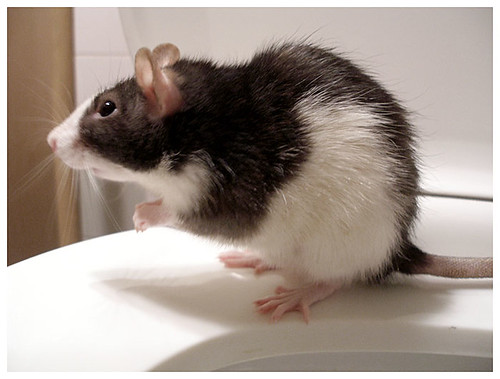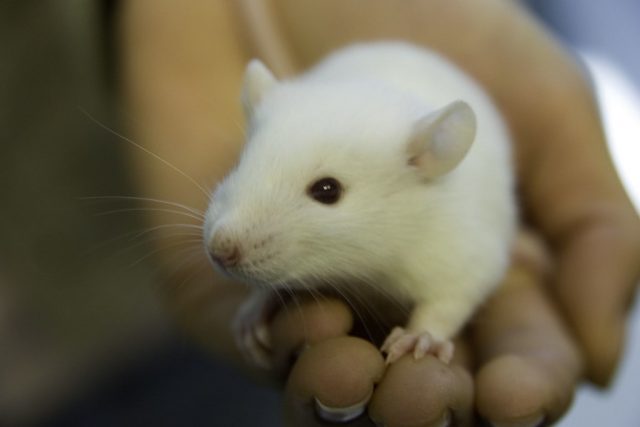Perhaps you read the title and thought, “What, bipedal…RATS?!”
I assure you, this is not a typo. I repeat, this is NOT a typo.
When I came across an offhand reference to this bizarre creature a few weeks ago, my curiosity was instantly stoked. I had to know what was going on.
My conclusion, after much research, is that scientists will find a way to use lab rats for anything. Since the 1920s, they (the scientists, that is) have been making and using bipedal rats to study several human conditions, including scoliosis and osteoarthritis.
Since I’m particularly interested in how bipedalism affects the spine, I focused on a set of four experiments that examined how bipedalism affected the vertebrae and intervertebral discs in rats. All four were performed by a group of researchers from Shanghai University of Traditional Chinese Medicine in China.
How Do You Make a Bipedal Rat?
I will warn you right now that lab animals do not always lead perfectly blessed and contented lives. The point of these experiments was not to make the rats happy.
In case you are wondering, the rats in these experiments weren’t born with two legs. They were born as normal, four-legged rats, and they presumably enjoyed scurrying around and gorging themselves on food pellets like their friends.
Before each experiment, a group of baby rats was delivered by a supply company. The animals were then divided into two groups. The rats in the first group lived out their lives as anatomically normal, four-legged creatures. The rats in the second group had their forelimbs amputated when they were four weeks old.
A question I never thought to ask was, why four weeks? But there is an answer. In previous experiments, researchers performed the amputations within a day or two of birth. The authors of the Shanghai experiments noted that, “However, high mortality in the infant rats prevents such a model from wide applications. Our previous research demonstrated that the optimal surgical time for the bipedal rat model is when the rats are at the age of about 1 month (unpublished observations) (Liang, et al. 2008).”
This assertion invites other questions, such as, just how did the researchers arrive at this conclusion? How many rats did they operate on? But on second thought, I don’t want to know.
After two weeks, the rats were transferred to custom-made cages. Their food and water were elevated so that the rats had to stand up on their hindlimbs to eat or drink.
At intervals ranging from 5 to 9 months after the surgery, some of the rats in both groups were killed, and their spines were analyzed and compared.

Photo courtesy of Socar Myles via Flickr.
Compact Discs
Bipedalism certainly didn’t spare the rats’ intervertebral discs. Compared to the control rats, the bipedal rats had thinner discs. Starting at the fifth month, small tears were visible in the outer part of the disc, the annulus fibrosis.
The pattern of gene expression changed as well. Genes that led to the creation of type II collagen (a major component of the disc’s nucleus) were not expressed as frequently in the bipedal rats, and genes that tag important proteins for destruction were expressed at higher rates (Liang, et al. 2008).
In a subsequent study, the researchers checked ten biomarkers associated with cellular senescence (a state in which cells stop dividing) in intervertebral discs. Sure enough, they discovered that molecules associated with senescence were present at higher rates, while molecules associated with healthy cells were present at lower rates (Xing, et al. 2010). The tentative conclusion is that the process of aging and degeneration is sped up in the bipedal rats.
Messy Plates & Thick Bones
The vertebral endplates also seemed to be damaged by upright walking. They were thinner, and their component proteins were more disorganized in the bipedal rats (Liang, et al. 2008). Over time, they also showed more signs of bony growth. This is important, because it could encourage the discs to deteriorate more quickly (Bian, Liang and Wan, et al. 2011).
Discs don’t have their own blood supply. Instead, they get their nutrients through the vertebral endplates. If the endplates thicken and become less permeable, you can see how that can basically starve the disc.
The bones of the vertebrae were also affected. Bone density was higher in the bipedal rats, and there were more cross-hatched beams of trabecular bone. Not surprisingly then, the bipedal rats had more osteoblasts (cells that build new bone). Certain proteins and biomarkers associated with building bones were more plentiful as well (Bian, Liang and Hou, et al. 2011).
You Can Make a Rat Walk on Two Legs, But You Can’t Make It Want To
Do bipedal rats actually behave like bipeds, and walk around on two legs?
At first, I found this question nearly as baffling as the existence of bipedal rats. Wouldn’t the answer be obvious to anyone who raises them? But apparently not. This is partly because rats are nocturnal, and their keepers are presumably not willing to watch them 24 hours a day.
A study from Kansas University quantified the difference between two-legged and four-legged rats. The researchers used infrared sensors to track the motion patterns of both types of rats over the course of a day. They found that the quadrupedal rats actually spent more time in an upright posture (an average difference of ~7.5 minutes) than did the bipedal rats. Both groups of rats stood up roughly the same number of times, and moved about as far on two legs.
For this reason, many scientists have become disenchanted with the use of bipedal rats. Several researchers who started out using them noticed they pretty much acted like rats with two legs, instead of acting like humans. The researchers concluded the results would not translate, and gave up on the rats (Bailey, et al. 2001).
The Shanghai researchers acknowledged that the changes they noticed might not be due to their rats adopting permanent two-legged postures. Instead, they speculated that the changes could be the result of poor motor control, or more bending and twisting of the spine (Xing, et al. 2010).
A related problem is that rats just don’t have the same muscles and ligaments that humans use to support their spines, and rats never develop humans’ characteristic S-curve. How well these finding transfer to humans is still up for debate.
References
- Bailey, Alexander S., Federico Adler, Sue Min Lai, and Marc A Asher. 2001. “A Comparison Between Bipedal and Quadrupedal Rats: Do Bipedal Rats Actually Assume an Upright Posture?” Spine (Lippincott Williams & Wilkins, Inc.) 26 (14): E308–313. doi:10.1097/00007632-200107150-00006.
- Bian, Qin, Qian-Qian Liang, Chao Wan, Wei Hou, Chen-Guang Li, Yong-Jian Zhao, Sheng Lu, Qi Shi, and Yong-Jun Wang. 2011. “Prolonged Upright Posture Induces Calcified Hypertrophy in the Cartilage End Plate in Rat Lumbar Spine.” Spine (Lippincott Williams & Wilkins) 36 (24): 2011-2020. doi: 10.1097/BRS.0b013e3181ffde92.
- Bian, Qin, Qian-Qian Liang, Wei Hou, Chao Wan, Chen-Guang Li, Yong-Jian Zhao, Sheng Lu, Qi Shi, and Yong-Jun Wang. 2011. “Prolonged and Repeated Upright Posture Promotes Bone Formation in Rat Lumbar Vertebrae.” Spine (Lippincott Williams & Wilkins) 36 (6): 380–387. doi:10.1097/BRS.0b013e3181dbc101.
- Liang, Qian-Qian, Quan Zhou, Min Zhang, Wei Hou, Xue-Jun Cui, Chen-Guang Li, Tian-Fang Li, Qi Shi, and Yong-Jun Wang. 2008. “Prolonged Upright Posture Induces Degenerative Changes in Intervertebral Discs in Rat Lumbar Spine.” Spine (Lippincott Williams & Wilkins) 33 (19): 2052–2058. doi:10.1097/BRS.0b013e318183f949.
- Xing, Qiu-Juan, Qian-Qian Liang, Qin Bian, Dao-Fang Ding, Xue-Jun Cui, Qi Shi, and Yong-Jun Wang. 2010. “Leg Amputation Accelerates Senescence of Rat Lumbar Intervertebral Discs.” Spine (Lippincott Williams & Wilkins) 35 (23): 1253–1261. doi:10.1097/BRS.0b013e3181e7d087.
